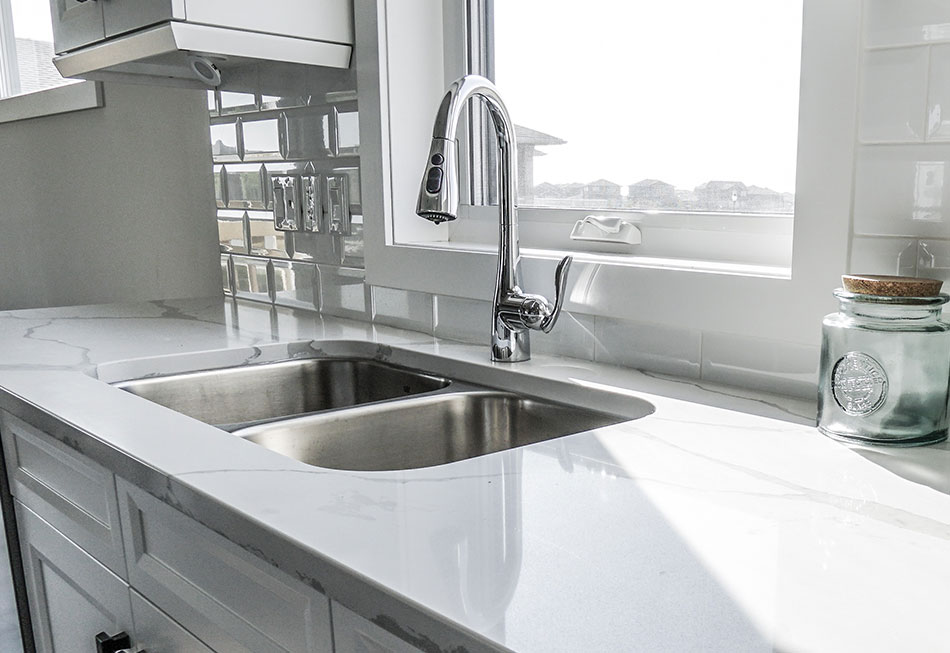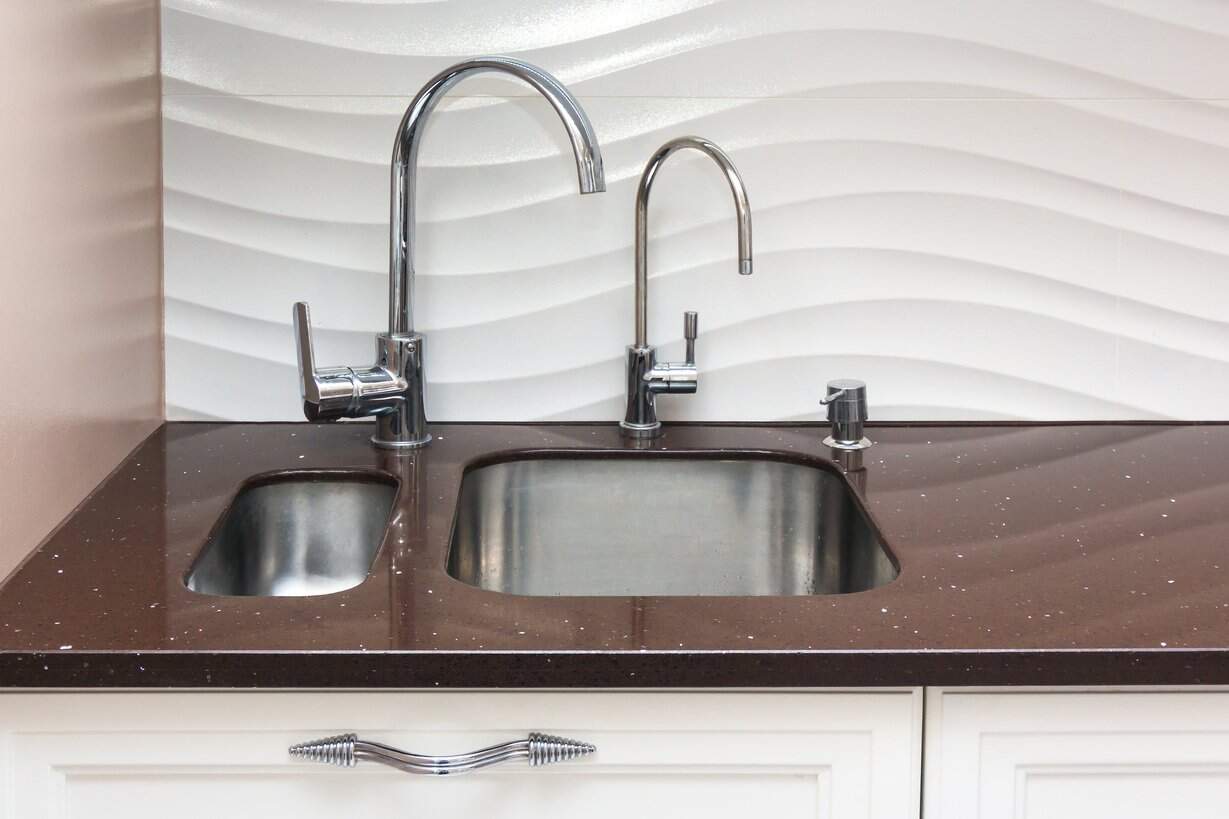Sealing a kitchen sink to granite is a simple task that can be completed in a few steps. Sealing the sink to the granite will prevent water from seeping into the granite, protecting it from damage and staining. To ensure a good seal, all surfaces should be cleaned and dried before applying the sealant. It is important to use the right sealant for the material you are working with and to follow the instructions for proper application. With the right materials and a few simple steps, you can easily seal your kitchen sink to granite for a perfect seal.
Sealing Kitchen Sink to Granite
Securing a kitchen sink to a granite countertop provides many advantages. Not only does it give the kitchen an elegant and sophisticated look, but it also helps ensure that the kitchen sink remains securely in place. Sealing a kitchen sink to granite also helps protect the sink from potential damage due to water leakage. Additionally, sealing the sink to granite prevents bacteria and mold from growing in the area, as it creates a water-resistant barrier.
The process of sealing a kitchen sink to granite is fairly simple and involves applying a sealant to the edges of the sink where it meets the granite countertop. This helps keep the sink securely attached and sealed to the granite, resulting in a secure and waterproof seal. Additionally, it helps to prevent water from leaking and seeping into the cracks and crevices of the granite, which can cause damage to both the granite and the kitchen sink.
The process of sealing a kitchen sink to granite is relatively low-cost and easy to do. With the right products and tools, it can be done quickly and easily, without requiring the help of a professional. By doing it yourself, you can save time and money and end up with a beautiful and elegant kitchen.
Tools and Materials Needed
One of the most important steps when it comes to sealing a kitchen sink to granite is having the right tools and materials. While the exact supplies may vary slightly depending on your particular kitchen, some of the most common items you will need include silicone caulk, a caulking gun, a utility knife, a tube of clear silicone sealant, a putty knife, a wet/dry vacuum, a sponge, and a rag. Having these items on hand before starting the job will make the process much easier. Additionally, it’s important to ensure you select a silicone caulk and silicone sealant that is specifically designed for use with granite, as other types of sealants may not be able to withstand the heat and moisture of a kitchen sink. With the right supplies and a bit of patience, you can easily seal your kitchen sink to granite.
Step-by-Step Guide for Sealing Kitchen Sink to Granite
Sealing a kitchen sink to granite can be a daunting task. However, by following the right steps, you can complete the job successfully. This guide will provide you with a step-by-step guide to help you seal a kitchen sink to granite with ease.
The first step is to measure the sink opening and cut a hole in the granite for the sink to fit. Make sure that the hole is the exact size of the sink and that the edges of the sink are flush with the granite. After cutting the hole, use a high-quality silicone caulk to seal the edges of the sink and granite. Make sure to apply the caulk evenly and fill any gaps.
The next step is to use a putty knife to apply the sink sealant around the edges of the sink. Make sure to apply the sealant in an even layer and smooth out any bubbles. After the sealant has dried, use a cloth to wipe away any excess sealant.
Once the sealant has dried, it is important to check the sealant for any cracks or breaks. If any cracks or breaks are found, you should apply additional sealant to ensure a good seal. Once the sealant has been applied and dried, it is important to use a wet cloth to wipe away any excess sealant.
By following these steps, you can easily seal a kitchen sink with granite. Make sure to use a high-quality sealant and follow the manufacturer’s instructions. Additionally, it is important to check the sealant regularly to ensure that it is still providing a good seal. With the right steps and materials, you can successfully seal a kitchen sink with granite.
Tips and Tricks for Sealing Kitchen Sink to Granite
Installing and sealing a kitchen sink into a granite countertop is a job that requires precision and attention to detail. Granite is a durable and attractive material for kitchen countertops, but it also requires specialized installation techniques to ensure a water-tight seal. Here are some tips and tricks to help you get the job done right and ensure your kitchen sink is securely attached and sealed to your granite countertop.
First, make sure to use a high-quality silicone caulk specifically designed for use with granite. Clear silicone caulk is recommended for a seamless look, but it is important to check the product label for approval for use with granite. Once you have your caulk, apply a generous layer of caulk around the sink cutout, and then press the sink into the cutout. Use a damp cloth to wipe away any excess caulk.
Next, use a caulking gun with a steady hand to apply a continuous bead of caulk around the perimeter of the sink. Make sure the caulk is free of any air bubbles or gaps. Allow the caulk to dry overnight, and use a putty knife to remove any excess caulk.
Finally, apply a sealant to the underside of the sink to help protect the sink from water damage. A silicone-based sealant is best for granite countertops, as this will provide the best protection from water damage. Remember to clean any excess sealant from the sink before allowing it to dry.
By following these tips and tricks, you can ensure your kitchen sink is securely and properly sealed to your granite countertop. With proper installation and sealing, your sink can provide years of trouble-free use.

Credit: www.advancedcabinetry.com
Common Problems and Solutions
When it comes to sealing a kitchen sink to granite, several common problems can arise. Understanding the potential issues, and how to solve them, can help you ensure a successful installation. One of the most common problems is that the sealant may not adhere correctly to the granite, or may not be applied evenly. This can cause water to seep through, and could even create structural damage over time. To ensure a secure seal, use a high-quality sealant specifically designed for granite countertops. Additionally, make sure the sink is completely clean before you apply the sealant. Any dirt or oils will prevent the sealant from adhering properly.
Another common problem is that the sealant may not be applied in an even layer. This can lead to air pockets or gaps which can compromise the seal. To ensure a smooth application, use a caulking gun and carefully run it along the joint, pushing out any air pockets. Lastly, the sealant can sometimes be difficult to remove. This is why it’s important to carefully inspect the sealant before application and use a product that is designed to be easily removed. If the sealant needs to be removed, use a heat gun to soften it before scraping it away. Following these tips can help ensure a successful installation and a long-lasting seal.
Alternatives to Sealing Kitchen Sink to Granite
When it comes to sealing your kitchen sink to granite countertops, there are a few options available. Sealing is an important step to take to protect your countertops from water damage and other common kitchen sink issues. But what if you don’t want to seal the sink to the granite? Are there alternatives?
The answer is yes, there are alternatives to sealing your kitchen sink to your granite countertops. One option is to use silicone caulk. This is a great way to create a waterproof barrier that will keep moisture and water out of the space between the sink and countertop. Another option is to use a stainless steel band or bracket. This will create an effective and secure seal between the sink and granite countertop, while still allowing the sink to be easily removed if necessary.
Finally, you can also opt for a drop-in or undermount sink installation. This will help to keep the sink securely in place, without the need to seal it to the countertop. This type of installation requires some professional installation, so it may be more expensive than other options.
Overall, there are a few alternatives to sealing your kitchen sink to granite countertops. From silicone caulk to stainless steel bands and brackets, to drop-in or undermount installations, there are a variety of options available to fit your needs and budget. It is important to weigh your options and decide which is the best fit for your kitchen.
Conclusion
Sealing a kitchen sink to granite is a relatively simple process to complete with the right tools and materials. Using silicone caulk and a utility knife, you can easily create a watertight seal between the sink and granite countertop. By taking the time to follow the steps outlined above, you can ensure that your sink is properly sealed and that your kitchen will remain free of water damage for years to come.


